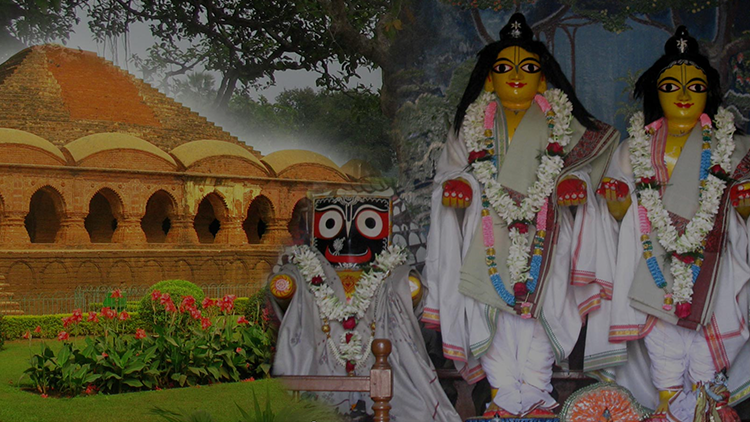Gaudiya-vaisnavism, a Tradition of Innovation
By Kaunteya Das | Feb 19, 2021

What’s tradition? It’s simply an idea or practice that has managed to be passed on for some time. Google defines tradition as: “the transmission of customs or beliefs from generation to generation.” Merriam-Webster offers other angles, defining it as “an inherited, established, or customary pattern of thought, action, or behavior (such as a religious practice or a social custom)” and “cultural continuity in social attitudes, customs, and institutions.”
Since Gaudiya-vaisnavism is based on Vedic revelation, which Gaudiyas accept as an eternal manifestation of knowledge, can be certainly considered traditional or traditionalistic. (You can’t get more traditional than eternity.) Its theological understanding have no beginning in historical time.
At the same time, when we go to analyze social attitudes, customs or behaviors, we encounter an exceptional flexibility in genuine Gaudiya-vaisnavism. We find an approach unchanging on principles but fluid on details.
In fact, we can say that Gaudiya-vaisnavism is a tradition of innovation, an ongoing, ceaseless effort at remaining relevant and relatable in changing social, political, economic and cultural circumstances.
Tradition in Gaudiya-vaisnavism is not a process of cutting-and-pasting external practices from the past.
The Vaisnavas don’t aspire to turn the present into a photocopy of bygone times. In fact the Gaudiya embrace the philosophy of yukta-vairagya and incorporate whatever useful to the mission, from computer to jet airplanes. This process of assimilation generates new traditions. Playing harmonium, for instance, is traditional in ISKCON, but the instrument itself is from Europe (and harmonium solos are still banned on All India Radio…)

It’s traditional in our sampradaya to present an eternal message within a constantly mutating environment, by a rigorous intellectual and spiritual effort to maintain the essence, the principles, intact, while adapting the external particulars according to the context – a constantly mutating context.
Following in the footsteps of the acaryas doesn’t mean simply mimicking outward, time-bound characteristics but acting with the same intent, serving the same objective. Tradition for Gaudiya-vaisnavas means acting with the same intention, discrimination and flexibility our previous acaryas demonstrated.
Innovation is our tradition.
The work is to the essence, the principles intact, while adapting details. And it’s expected that there will always be dialogue – even debate – on what constitutes an unchangeable principle, and what are discardable particulars.
Passages from the Srila Prabhupada Lilamrita offer a glimpse of our Founder-Acarya’s attitude. The first is from Chapter 22:
San Francisco’s largest paper, the Chronicle, also ran an article: “Swami in Hippie-Land – Holy Man Opens S.F. Temple.” The article began, “A holy man from India, described by his friend and beat poet Allen Ginsberg as one of the more conservative leaders of his faith, launched a kind of evangelistic effort yesterday in the heart of San Francisco’s hippie haven.”
Srila Prabhupada objected to being called conservative. He was indignant: “Conservative? How is that?”
“In respect to sex and drugs,” Mukunda suggested.
“Of course, we are conservative in that sense,” Prabhupada said. “That simply means we are following shastra. We cannot depart from Bhagavad-gītā. But conservative we are not. Caitanya Mahaprabhu was so strict that He would not even look on a woman, but we are accepting everyone into this movement, regardless of sex, caste, position, or whatever. Everyone is invited to come chant Hare Kṛṣṇa. This is Caitanya Mahaprabhu’s munificence, His liberality. No, we are not conservative.”
The second example is from Chapter 49:
“You cannot find in Kali-yuga that everything is being done very correctly to the point; that is very difficult. Just like our poet Allen Ginsberg, he was always accusing me, ‘Swamiji, you are very conservative and strict.’ Actually I told him, ‘I am never strict. Neither I am conservative. If I become conservative, then I cannot live here for a moment.’ So I am not at all conservative.
Srila Prabhupada rejected the label “conservative,” and in his books he elaborates on the adaptability of the missionary efforts. Below we offer a few examples from his purports:
“The Krishna consciousness movement is not stereotyped or stagnant.” (Cc Adi, 7.28, purport)
“Lord Caitanya Mahaprabhu wanted to invent a way to capture the Mayavadis and others who did not take interest in the Krishna consciousness movement. This is the symptom of an acharya. An acharya who comes for the service of the Lord cannot be expected to conform to a stereotype, for he must find the ways and means by which Krishna consciousness may be spread. Sometimes jealous persons criticize the Krishna consciousness movement because it engages equally both boys and girls in distributing love of Godhead. Not knowing that boys and girls in countries like Europe and America mix very freely, these fools and rascals criticize the boys and girls in Krishna consciousness for intermingling. But these rascals should consider that one cannot suddenly change a community’s social customs. However, since both the boys and the girls are being trained to become preachers, those girls are not ordinary girls but are as good as their brothers who are preaching Krishna consciousness. Therefore, to engage both boys and girls in fully transcendental activities is a policy intended to spread the Krishna consciousness movement. These jealous fools who criticize the intermingling of boys and girls will simply have to be satisfied with their own foolishness because they cannot think of how to spread Krishna consciousness by adopting ways and means that are favorable for this purpose. Their stereotyped methods will never help spread Krishna consciousness. Therefore, what we are doing is perfect by the grace of Lord Caitanya Mahaprabhu, for it is He who proposed to invent a way to capture those who strayed from Krishna consciousness.” (Cc Adi, 7.31-32, purport)
“Personal realization does not mean that one should, out of vanity, attempt to show one’s own learning by trying to surpass the previous acharya. He must have full confidence in the previous acharya, and at the same time he must realize the subject matter so nicely that he can present the matter for the particular circumstances in a suitable manner. The original purpose of the text must be maintained. No obscure meaning should be screwed out of it, yet it should be presented in an interesting manner for the understanding of the audience.” (SB 1.4.1, purport)
“The method of worship — chanting the mantra and preparing the forms of the Lord — is not stereotyped, nor is it exactly the same everywhere. It is specifically mentioned in this verse that one should take consideration of the time, place and available conveniences. Our Krishna consciousness movement is going on throughout the entire world, and we also install Deities in different centers. Sometimes our Indian friends, puffed up with concocted notions, criticize, ‘This has not been done. That has not been done.’ But they forget this instruction of Narada Muni to one of the greatest Vaishnavas, Dhruva Maharaja. One has to consider the particular time, country and conveniences. What is convenient in India may not be convenient in the Western countries. Those who are not actually in the line of acharyas, or who personally have no knowledge of how to act in the role of acharya, unnecessarily criticize the activities of the ISKCON movement in countries outside of India. The fact is that such critics cannot do anything personally to spread Krishna consciousness. If someone does go and preach, taking all risks and allowing all considerations for time and place, it might be that there are changes in the manner of worship, but that is not at all faulty according to shastra. Srimad Viraraghava Acharya, an acharya in the disciplic succession of the Ramanuja sampradaya, has remarked in his commentary that chandalas, or conditioned souls who are born in lower than shudra families, can also be initiated according to circumstances. The formalities may be slightly changed here and there to make them Vaishnavas.” (SB 4.8.54, purport)
“The expert devotees also can discover novel ways and means to convert the non-devotees in terms of particular time and circumstance. Devotional service is dynamic activity, and the expert devotees can find out competent means to inject it into the dull brains of the materialistic population. Such transcendental activities of the devotees for the service of the Lord can bring a new order of life to the foolish society of materialistic men. Lord Sri Caitanya Mahaprabhu and His subsequent followers exhibited expert dexterity in this connection.”
Inventiveness, creativity and innovation are thus integral elements of the Gaudiya tradition. But to be able to discriminate between a bona fide adaptation and a deviation requires a deep absorption in the theology, in the standard literature and in the spirit of the sampradaya.















